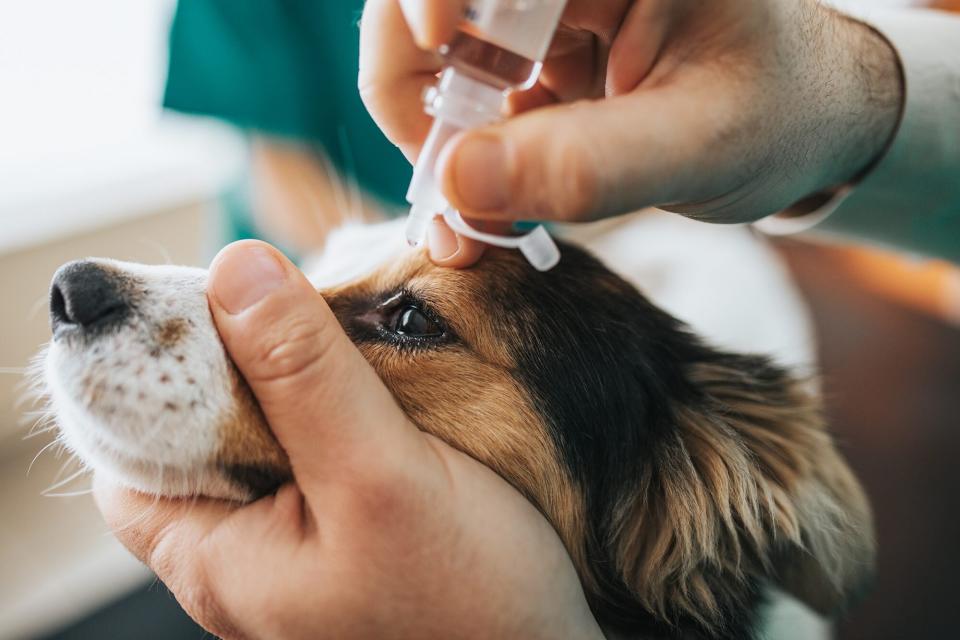Canine Conjunctivitis: How to Recognize and Treat Pink Eye in Dogs
Pink eye, also known as conjunctivitis, presents similarly in dogs as it does in people. Characterized by red or pink irritated eyes and often accompanied by discharge, this common eye infection is not a pleasant experience for dogs or owners but is luckily treatable in most circumstances.
Conjunctivitis in dogs can have many different causes, many of which require specific treatments, so it's a good idea to see your veterinarian if you begin to notice symptoms of pink eye in your pooch. Because of this, it is helpful to know the basics of the disease so you can keep an eye out (literally) for anything concerning.
How Do Dogs Get Pink Eye?
Nikki Graham, DVM from Nottingham Animal Hospital in Hamilton, N.J., explains that pink eye is usually either allergic or bacterial in dogs. She says, "They can get it from inhalant allergies, such as pollen or grass, or from a secondary bacterial infection from a topical irritant, like smoke, sand, or wind from hanging their heads out the car window."
Graham goes on to explain that other causes of conjunctivitis in dogs can include factors such as entropion, or rolled in eyelids, or keratoconjunctivitis sicca, also known as dry eye, in which dogs don't produce enough tears. Pink eye can be a condition on its own, or it can be a symptom of a different eye disease.
In addition to physical irritants in the eye, abnormal eyelids or eyelashes, dry eye, and allergies, other possible causes of conjunctivitis in dogs include certain parasites, tumors, and trauma. In most cases, the cause of pink eye will determine the treatment, so it's important to consult your veterinarian before attempting to treat your dog's pink eye on your own.
RELATED: Cherry Eye: What It Is & When to Seek Help for Your Dog
Symptoms of Dog Pink Eye
Staying on the lookout for common conjunctivitis symptoms means that you may catch cases early, potentially leading to easier treatment and overall better health outcomes for your dog.
These symptoms are very similar to the symptoms we associate with pink eye in humans, including:
Redness
Discharge that can appear clear or a mucous texture
Inflammation
Swelling around the eyes
If you notice your dog rubbing or pawing at their eyes, or squinting or blinking more than usual, this can also be a sign that they are experiencing irritation that might not yet be visible to you.
These symptoms can appear in both eyes or in just one, and are sometimes accompanied by other symptoms, such as nasal discharge, coughing, or sneezing.
Is Conjunctivitis Contagious in Dogs?
Pink eye is notoriously contagious in humans, but luckily, Graham says most cases in dogs are not contagious to people or other dogs.
However, as always, it's best to consult your veterinarian about your dog's specific case to determine how careful you should be until their conjunctivitis clears up.
Graham adds that this is not usually the case for conjunctivitis in cats, which she says is "usually caused by a virus (herpesvirus) or other infectious agent that can be contagious between cats and can occasionally be spread to humans."

skynesher / Getty
Dog Conjunctivitis Treatments and Home Remedies
"Eye conditions can get better quickly," Graham explains, "but they can also progress to more serious conditions if left untreated or treated incorrectly." Because of this, it's important that you don't attempt to treat an undiagnosed eye condition by yourself, as medication for one condition may worsen another.
Your vet will likely perform a variety of diagnostic tests to determine and develop the treatment plan that is best for your dog. Eye drops are one of the most common treatments for pink eye in both dogs and humans, but the specific drops may differ depending on your dog's case. Your vet can determine what eye drops are best for your dog and show you how to safely apply them.
Certain causes of pink eye may require other treatments, such as medications or surgical procedures. While it might be tempting to try home remedies to treat your dog's conjunctivitis at home, this is not a good idea, and it is absolutely worth it to take your dog to a veterinarian to get a diagnosis first.
How to Prevent Pink Eye in Dogs
While some causes of pink eye in dogs are nearly impossible to prevent, such as dry eye or entropion, many conjunctivitis cases can be prevented. According to Graham, one of the easiest actions you can take to reduce the chances of your dog developing pink eye is to avoid letting your dog hang their head out of a moving car's window. Not only can your dog's eyes be struck by flying debris, but even the wind itself can irritate your dog's eyes.
Ensuring your dog is up-to-date on vaccinations can also help reduce the likelihood of viral causes of conjunctivitis. It is also a good idea to supervise your dog while they play to discourage play that might result in eye injuries. However, in terms of preventing pink eye, the absolute best thing you can do for your dog is to take them to the vet as soon as you notice eye symptoms or discomfort. Catching conjunctivitis early can greatly reduce the severity of the condition, making it much easier to treat.

